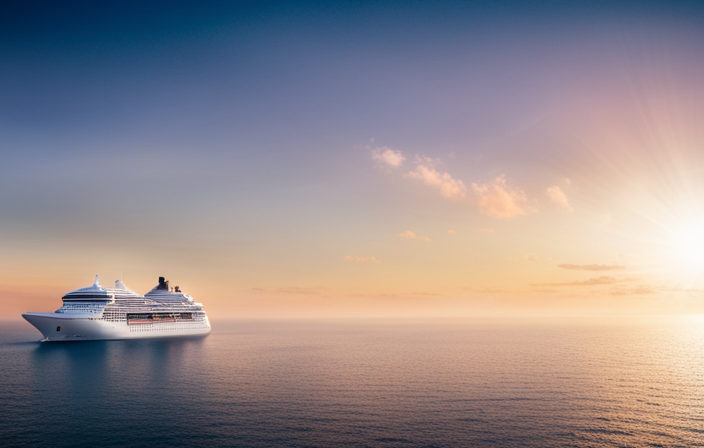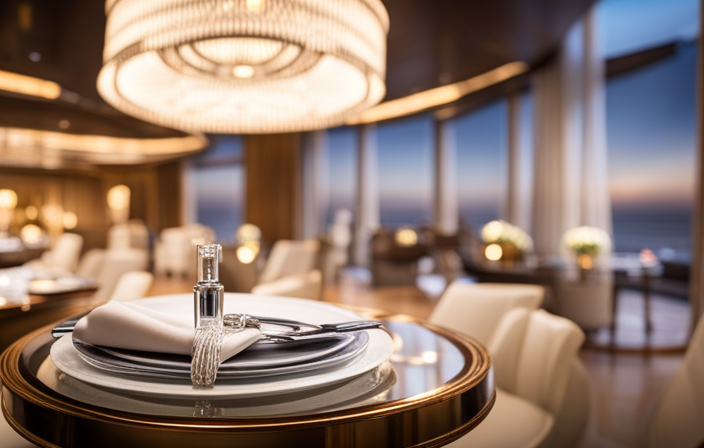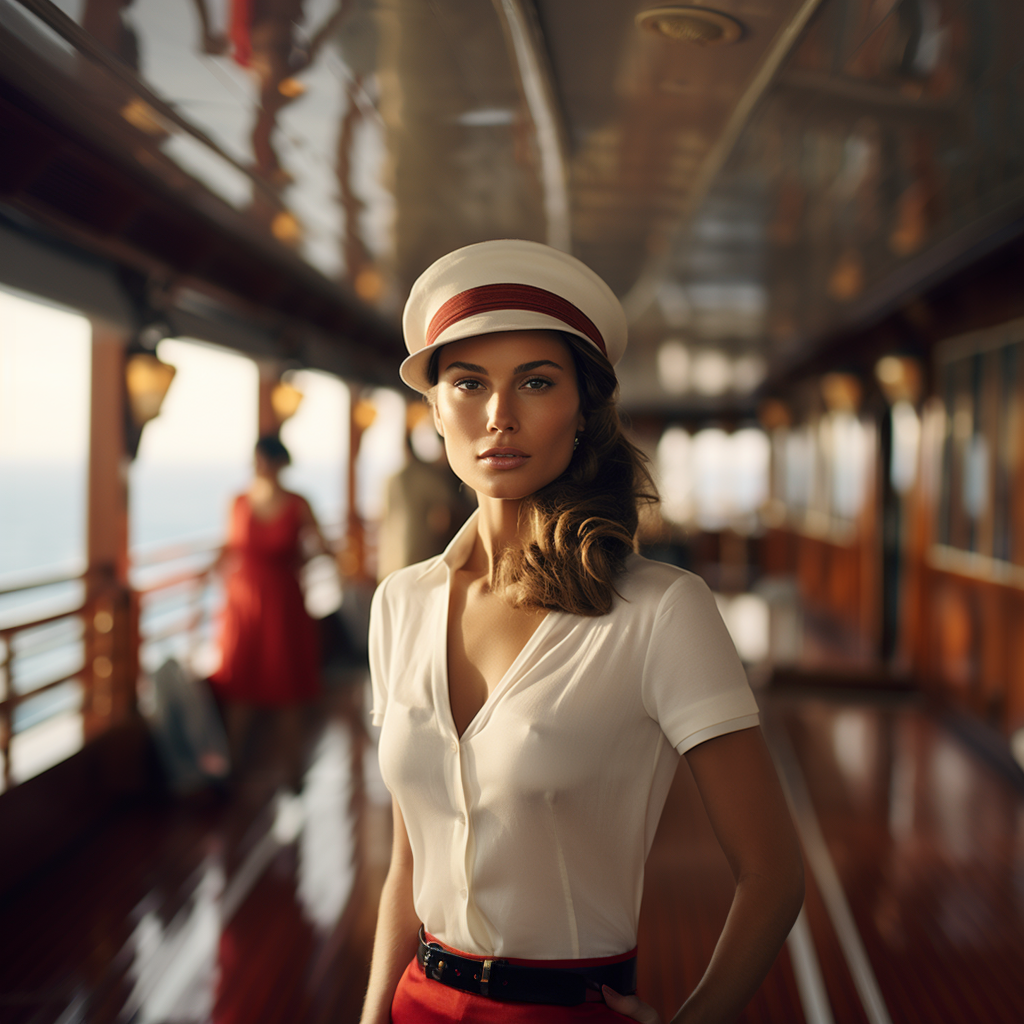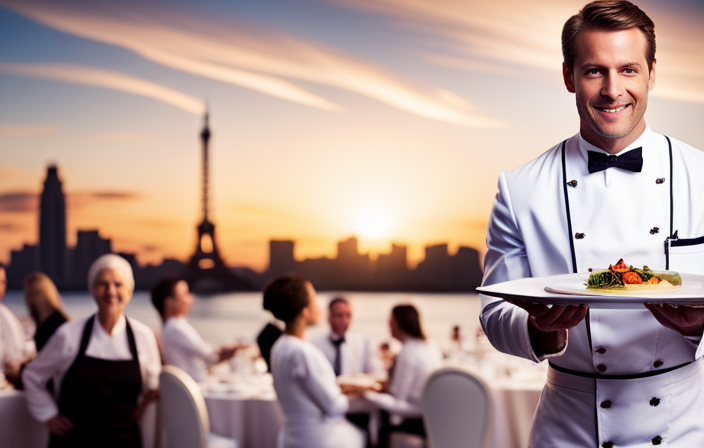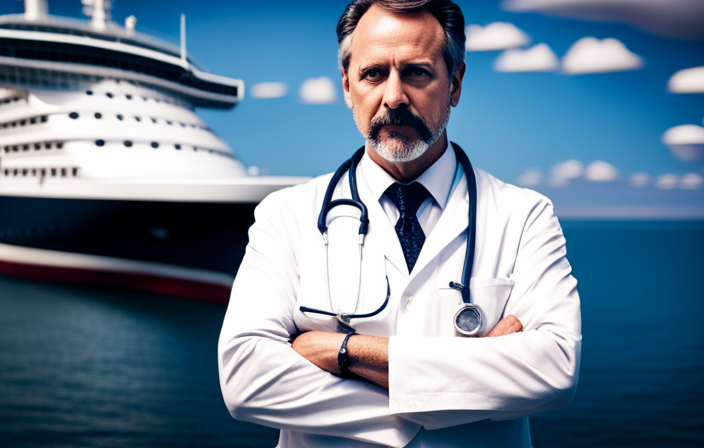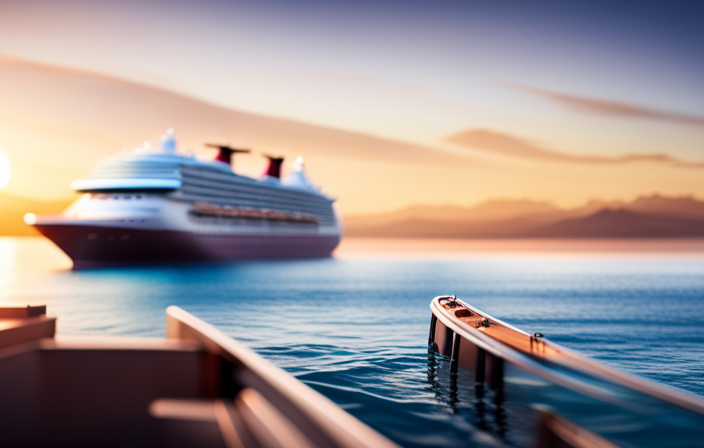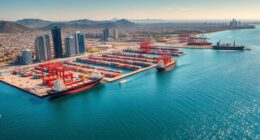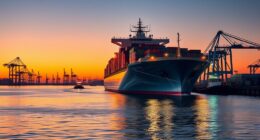Have you ever thought about why cruise ships, despite being large and heavy, are able to stay buoyant and not capsize? This inquiry has intrigued me for quite some time. As I explored the realm of naval architecture and maritime engineering, I uncovered a captivating assortment of ideas and elements that contribute to the stability of these enormous vessels.
Imagine a tightrope walker gracefully balancing on a thin wire, defying gravity with every step. Just like the rope supports the acrobat’s weight, cruise ships rely on the principle of buoyancy to stay afloat.
The design of these vessels takes into account not only their immense size but also advanced navigation systems, weight distribution techniques, and resistance to external forces.
But it doesn’t end there. Crew expertise and training play an essential role in maintaining stability at sea. Regular inspections, adherence to international maritime regulations, and continuous innovation further enhance safety measures.
In this article, we will explore the intricate mechanisms behind why cruise ships remain upright in even the harshest conditions. So grab your life jacket as we embark on this technical journey through the world of ship stability.
Key Takeaways
- Proper engine and machinery maintenance is crucial for smooth operations, safety, and optimal performance of cruise ships.
- Regular hull inspections and repairs are essential to maintain stability, prevent tipping over, and ensure the integrity of the ship.
- Safety equipment checks and crew expertise and training play a vital role in ensuring the overall security and stability of cruise ships.
- International maritime regulations, continuous innovation, and hull coating are important factors in maintaining stability and preventing tipping risks.
Understanding the Principles of Buoyancy
You may be wondering why cruise ships don’t tip over, but let me tell you, it’s all about the incredible power of buoyancy that keeps these massive vessels afloat.
The principles of buoyancy play a crucial role in ensuring the stability and flotation techniques of cruise ships. Buoyancy is the upward force exerted by a fluid on an object immersed in it, which opposes the weight of the object.
Cruise ships are designed to displace a large volume of water, creating an upward force that counteracts their weight. This is achieved through clever engineering, such as incorporating hollow spaces called ballast tanks and using lightweight materials.
Additionally, careful attention is given to the ship’s center of gravity and balance to prevent any tilting or tipping incidents.
Now, let’s delve into how structural design and stability features further enhance cruise ship safety and performance without compromising their elegant appearance.
Structural Design and Stability Features
With their carefully engineered design and stability features, cruise ships are able to maintain their balance even in rough seas. One key aspect of their structural design is the selection of appropriate materials. Cruise ships are typically constructed using high-strength steel, which provides the necessary strength and durability to withstand the forces exerted by waves and wind. This choice of material ensures that the ship remains stable and resistant to tipping over under normal operating conditions.
Additionally, cruise ships incorporate various stability features to counteract the impact of weather conditions. They have a wide hull form with a low center of gravity, which helps to distribute the weight evenly and enhance stability. Furthermore, they are equipped with stabilizer fins or wings that extend from the sides of the hull. These fins can be adjusted to counteract rolling motions caused by waves, further enhancing stability.
Transitioning into the subsequent section about ‘advanced navigation and control systems,’ these structural design and stability features provide a solid foundation for ensuring safe operation in challenging maritime environments.
Advanced Navigation and Control Systems
Equipped with state-of-the-art navigation and control systems, cruise ships navigate treacherous waters with precision, instilling a sense of awe and wonder in passengers. These advanced technology systems include sophisticated autopilot systems that ensure accurate course plotting, speed control, and collision avoidance. By utilizing sensors, radar, and GPS technology, these systems continuously monitor the ship’s position and surroundings to make real-time adjustments as needed. The autopilot system takes into account factors such as wind speed, currents, and sea conditions to optimize the ship’s stability during navigation.
To emphasize the importance of these advanced navigation and control systems in maintaining stability, consider the following table:
| Navigation System | Function |
|---|---|
| Autopilot | Controls course plotting |
| Radar | Detects nearby objects |
| GPS | Provides precise location |
These technologies work together seamlessly to ensure safe passage through unpredictable waters. Transitioning into the subsequent section about ‘the role of weight distribution,’ it is important to understand how these navigation and control systems rely on proper weight distribution for optimal performance.
The Role of Weight Distribution
The role of weight distribution is crucial in maintaining stability and preventing tipping over on a cruise ship. Cruise ships are engineered to distribute weight evenly across their length and width. This ensures that the center of gravity remains low and centered. Heavy components such as engines, fuel tanks, and ballast are strategically placed throughout the ship to achieve this balance. Stability measures, including anti-roll stabilizers and bilge keels, also contribute to maintaining equilibrium by counteracting rolling motions. Precise calculation of weight distribution is essential in preventing excessive listing or heeling, which could compromise the ship’s stability. In the next section on resistance to external forces, we will explore how weight distribution interacts with other factors to ensure smooth sailing while prioritizing safety.
Resistance to External Forces
As you explore the resistance to external forces, you’ll discover the impressive ways cruise ships are designed to withstand powerful waves and maintain stability.
-
Underwater pressure: Cruise ships are built with a deep draft, allowing them to displace a large amount of water. This creates a counteracting force against the pressure exerted by the waves, preventing tipping over.
-
Wind resistance: The shape of cruise ships is carefully designed to minimize wind resistance. By incorporating sleek lines and aerodynamic features, they can effectively reduce the impact of strong winds and maintain their stability.
These design considerations ensure that cruise ships can resist external forces that may cause instability. However, it’s important to note that safety measures and emergency preparedness play a crucial role in maintaining passenger well-being during unforeseen circumstances.
Therefore, let’s now delve into how cruise ships prioritize safety measures and emergency preparedness without compromising on comfort and luxury.
Safety Measures and Emergency Preparedness
Feel secure and confident as you board a cruise ship, knowing that safety measures and emergency preparedness have been meticulously planned to protect you in any unforeseen circumstances.
Cruise ships are equipped with comprehensive emergency response protocols designed to ensure passenger safety at all times. These protocols include regular drills and training sessions for the crew members, so they can efficiently respond to emergencies such as fires, medical incidents, or even potential terrorist threats.
Additionally, cruise ships have advanced communication systems in place to quickly relay information during emergencies and coordinate rescue efforts if needed. Escape routes, lifeboats, and life jackets are strategically placed throughout the ship to facilitate evacuation procedures.
Rest assured that every precaution is taken by cruise lines to prioritize your safety on board.
As we transition into the subsequent section about regular inspections and maintenance, it is important to understand how these practices contribute to the overall security of cruise ships.
Regular Inspections and Maintenance
Regular inspections and maintenance are crucial for ensuring the safety and functionality of cruise ships.
Hull inspections and repairs are vital to prevent any structural weaknesses or potential leaks that could compromise the vessel’s stability.
Engine and machinery maintenance is essential to guarantee smooth operations and prevent any mechanical failures that could lead to accidents or breakdowns at sea.
Additionally, regular safety equipment checks ensure that all necessary life-saving devices are in proper working order, ready to be deployed in case of emergencies.
Overall, these meticulous inspections and maintenance procedures play a significant role in keeping cruise ships safe and secure for both passengers and crew members.
Hull Inspections and Repairs
Inspecting and repairing the hull of your cruise ship is essential for its stability and safety. Regular inspections should be conducted to check for any signs of damage or wear. Promptly making repairs is crucial to prevent tipping over and maintain the ship’s integrity. The hull coating is a key component in protecting the structure from corrosion. Applying high-quality coatings that offer effective barrier protection against water and other corrosive elements is necessary to prevent weakening of the ship. Regular inspections help identify any areas where the coating may have deteriorated or been damaged, allowing for timely repairs. Thorough inspections also help detect potential structural issues that could impact the ship’s stability. By prioritizing hull inspections and necessary repairs, we ensure the continued safety and stability of our cruise ships.
Moving on to engine and machinery maintenance…
Engine and Machinery Maintenance
To ensure smooth sailing and prevent mechanical breakdowns, it is essential to keep the engines and machinery of your cruise ship well-maintained. Proper engine maintenance is crucial for optimal performance, efficiency, and fuel consumption. Neglecting routine inspections and repairs can lead to decreased efficiency and increased fuel consumption, resulting in higher operating costs.
To maintain engine efficiency, follow these steps:
- Regularly inspect the engine components for wear and tear.
- Clean and lubricate moving parts to reduce friction.
- Monitor fuel quality and ensure proper filtration.
By adhering to these maintenance practices, you can maximize engine performance while minimizing fuel usage. This not only reduces operational expenses but also helps in reducing environmental impact by decreasing carbon emissions. Maintaining a well-functioning engine is an essential part of ensuring the safety and reliability of your cruise ship’s operations.
Moving on to safety equipment checks…
Safety Equipment Checks
Ensuring the proper functioning of safety equipment is crucial for the overall security and well-being of passengers on board a cruise ship. Safety equipment efficiency plays a vital role in emergency response readiness.
Regular checks are conducted to verify that all safety equipment, such as lifeboats, life jackets, fire extinguishers, and alarm systems, are in optimal working condition. These inspections assess the functionality and reliability of each item, ensuring they can be deployed swiftly and effectively during an emergency situation.
Additionally, maintenance protocols are implemented to guarantee that safety equipment remains operational at all times. This includes routine testing, calibration, and replacement of outdated or damaged components. By meticulously monitoring safety equipment efficiency, cruise ships prioritize passenger safety by minimizing response time and maximizing the effectiveness of emergency procedures.
Transitioning to the subsequent section about crew expertise and training highlights another critical aspect in maintaining a secure environment onboard without delay.
Crew Expertise and Training
The crew’s expertise and training are crucial in ensuring the safety and stability of a cruise ship. They undergo rigorous training programs that equip them with the necessary skills for their duties. This includes navigation and emergency response protocols. Their extensive knowledge allows them to effectively carry out their duties even in challenging situations.
Operational procedures are also in place to maintain stability during various operations such as loading and unloading passengers, cargo, or fuel. These procedures involve proper weight distribution, ballasting techniques, and monitoring systems that constantly assess the ship’s stability. By adhering to these guidelines and utilizing their expertise, crew members play a crucial role in preventing any potential risks of capsizing or instability on board.
Furthermore, international maritime regulations further enhance safety measures without compromising efficiency and functionality. Understanding and complying with these regulations is essential for the crew to ensure the safety of the ship and its passengers.
International Maritime Regulations
Moving on to the current subtopic, let’s discuss the role of international maritime regulations in ensuring the stability of cruise ships. These regulations are established by governing bodies such as the International Maritime Organization (IMO) and serve as a set of guidelines for ship design, construction, and operation. Cruise ships must adhere to these regulations to obtain certification from classification societies like Lloyd’s Register or Det Norske Veritas.
The regulations specify minimum stability criteria that cruise ships must meet to ensure they remain upright even in rough seas.
They outline requirements for watertight compartments and systems that help prevent flooding and maintain buoyancy.
They also cover stability testing procedures and safety drills to prepare crew members for emergency situations.
These international maritime laws play a crucial role in maintaining the safety and stability of cruise ships, providing assurance to passengers that their vessels are built and operated in accordance with industry standards.
As we delve into the next section about continuous innovation and improvement, we will explore how these regulations drive advancements in ship design and technology.
Continuous Innovation and Improvement
Continuous innovation and improvement in the cruise ship industry drives advancements in ship design and technology, ensuring a constant evolution that enhances the safety and stability of these vessels. Through continuous improvement, cruise ships are equipped with state-of-the-art technologies that mitigate the risks associated with tipping over. These technological advancements include sophisticated stabilizer systems, which help counteract the natural forces that can cause a ship to tip. Additionally, advanced navigation systems and improved engineering designs contribute to better maneuverability and stability during challenging weather conditions. The table below highlights some key innovations in cruise ship technology:
| Technological Advancements | Benefits |
|---|---|
| Sophisticated stabilizer systems | Counteracts tipping forces |
| Advanced navigation systems | Improved maneuverability |
| Enhanced engineering designs | Increased stability |
By continuously investing in research and development, the cruise ship industry ensures that their vessels remain at the forefront of safety and stability, providing passengers with peace of mind while enjoying their vacation at sea.
Frequently Asked Questions
How do cruise ships maintain stability in rough seas?
In rough seas, the stability of a cruise ship is maintained by the careful design and placement of stabilizers. These devices counteract the impact of wave height and help to maintain balance and prevent tipping.
What are the safety measures in place to prevent tipping over during extreme weather conditions?
To prevent tipping over during extreme weather conditions, cruise ships have several safety precautions in place. These include advanced engineering designs such as stabilizers and ballast systems, which help maintain stability by counteracting the forces of wind and waves.
Are there any weight distribution techniques used specifically to enhance stability?
Weight distribution techniques are crucial for enhancing stability on cruise ships. By strategically placing heavy objects low in the ship’s center of gravity, we can minimize the risk of tipping over during extreme weather conditions.
How often are cruise ships inspected for structural integrity and stability?
Cruise ships undergo regular structural integrity inspections and stability checks to ensure their safety. These examinations are conducted by trained professionals who meticulously assess the ship’s structure, stability systems, and overall integrity to prevent any potential issues from arising.
What training and expertise do crew members receive to ensure the stability of the ship?
Crew members receive extensive training and expertise to ensure ship stability. They are trained in navigation, emergency procedures, and maintenance protocols. Their expertise allows them to assess and address any potential issues that may affect the stability of the ship.
Conclusion
In conclusion, cruise ships don’t tip over due to a combination of factors. The principles of buoyancy ensure that the ship’s weight is evenly distributed, allowing it to stay afloat.
The structural design and stability features provide strength and balance, while advanced navigation and control systems help navigate through various conditions.
Weight distribution plays a crucial role in maintaining stability, along with resistance to external forces.
Regular inspections and maintenance ensure the ship’s integrity, while crew expertise and training uphold safety measures.
Adhering to international maritime regulations drives continuous innovation and improvement in ship design and operation.
As they say, ‘smooth sailing’ isn’t just an idiom; it’s a testament to the intricate mechanisms that keep cruise ships upright on the open seas.
Meet Asra, a talented and adventurous writer who infuses her passion for exploration into every word she writes. Asra’s love for storytelling and her insatiable curiosity about the world make her an invaluable asset to the Voyager Info team.
From a young age, Asra was drawn to the power of words and their ability to transport readers to far-off lands and magical realms. Her fascination with travel and cultures from around the globe fueled her desire to become a travel writer, and she set out on a journey to turn her dreams into reality.

